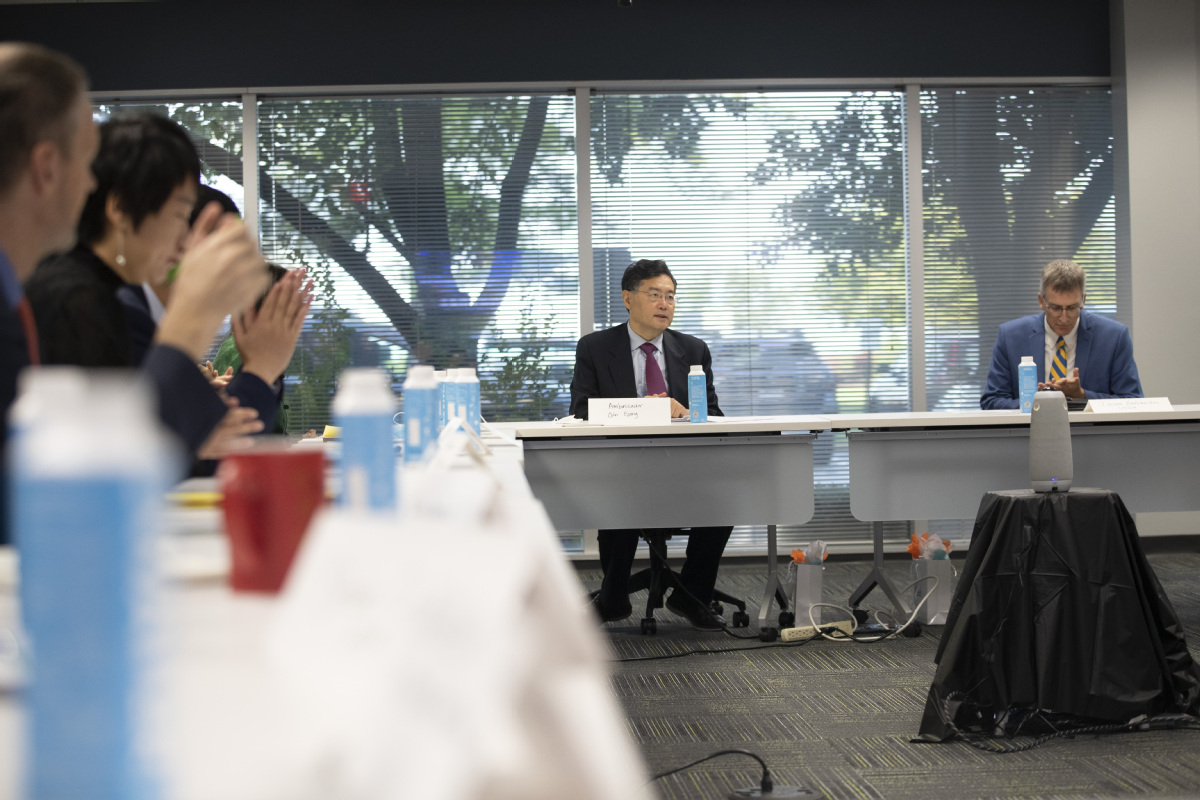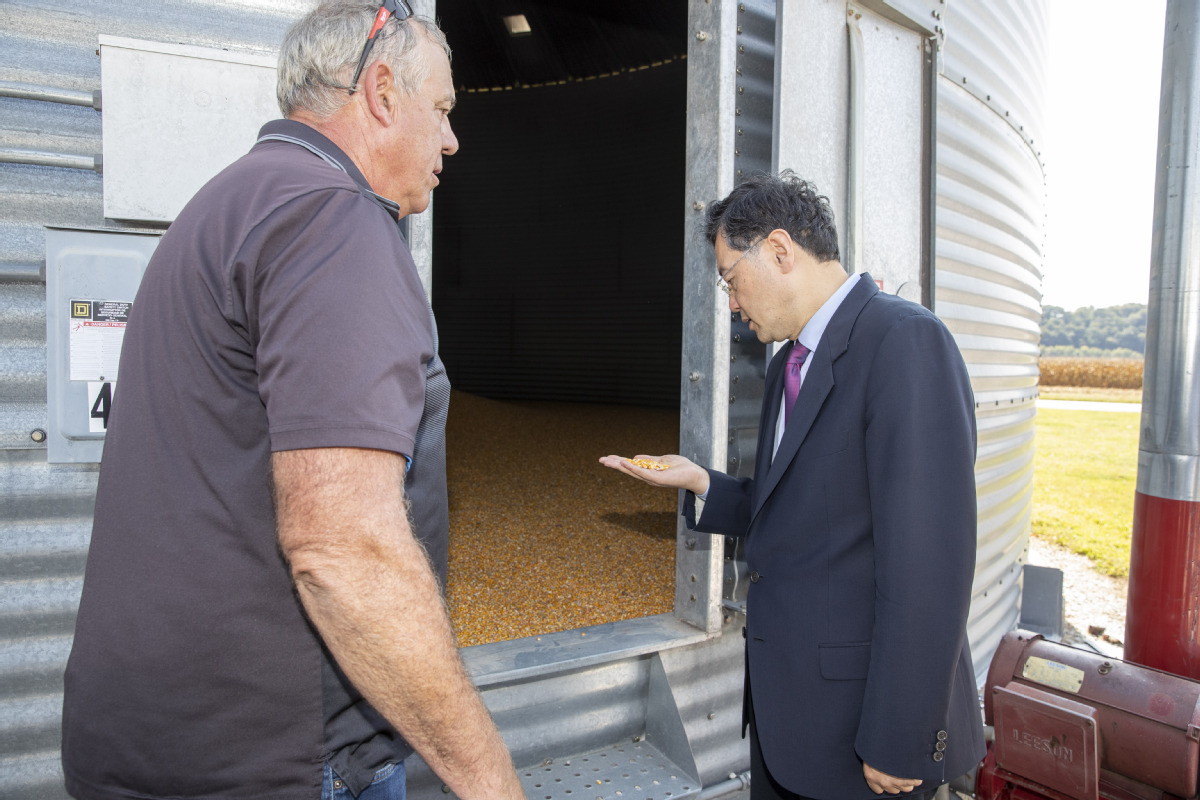September 19, 2022
MISSOURI – Chinese Ambassador to the US Qin Gang conducted another Midwest agriculture trip on Friday. He said China and the US, as two major agriculture countries, should build deep cooperation in agricultural technology, climate action and sustainable development.
“I believe as China pursues high-quality development, our demand for technology and services in agriculture green development will become as strong as that for agriculture products,” he said at the US-China Sustainability and Climate Smart Agriculture Roundtable Discussion in St Louis, Missouri, on Friday.
“Our market will remain open and we will continue to share the huge opportunities with American farmers, ventures, institutions, and the companies who want to collaborate with China,” said Qin.
Both China and the US are major agriculture countries. “It is our common responsibility to promote sustainable agriculture and to protect global food security for future generations,” Qin said.
In April, Qin had an agriculture-focused tour through Illinois, Iowa and Minnesota, where he got to know many American farmers and friends devoted to China-US agriculture cooperation, Qin said.
“I saw how the seeds of such cooperation get deeply rooted in the vast heartland,” Qin said. “I promise to my friends in the heartland: see you in the harvest. So today I’m back.”

Chinese Ambassador to the US Qin Gang attends the US-China Sustainability and Climate Smart Agriculture Roundtable Discussion in St Louis, Missouri on Friday. He said China and the US should build deep cooperation in agricultural green development. LIAO PAN / FOR CHINA DAILY
Qin said he was deeply interested by American agriculture during his last trip. “We have seen that American farmers and agriculture business need China, benefit from China, and look forward to greater engagement with China,” Qin said.
He said he was lucky to be a “one-day farmer” at the Kimberley farm in Iowa, which President Xi Jinping cited as an example of modern farming technology when he visited as vice-president of China.
“We have come to know that American agriculture is going through a green and low-carbon transition. Advance technologies in seed breeding, digital farming, machinery, and equipment as well as proven farming practices, all contributes to efficient and sustainable production,” he said.
American farms have not only reduced greenhouse gas emission, but also achieved the carbon capture and the sequestration, he said. Qin believes the China-US agriculture cooperation should go beyond the simple model and go deep into agricultural technology, climate action and the sustainable development.
China has set the targets to reach carbon peaking before 2030 and the carbon neutrality before 2060.
“Though we have not yet completed industrialization and urbanization, with a constant energy demand, we are determined to meet these targets within this short timeframe,” said Qin. “This is our commitment to the people and to building a community with a shared future for mankind.”
“President Xi Jinping has said to our farmers many times, clean waters and green mountains are as valuable as gold and silver. We believe agriculture is a contributor to China’s green development, and agriculture can also create new growth potential,” said Qin.
Qin said that China has been working actively on agricultural green development in recent years. China has introduced laws in the regulations, in black soil protection, realized the zero increase in the use of a chemical fertilizer and the pesticide, and promoted the application of information technology and the digital farming, according to Qin.
China’s policies, technologies, and expertise in sustainable development of agriculture are steadily improving, he said.
Several global leading companies in seed and the crop protection whose research and development bases are in the US are contributing products and the farming solutions to China’s green development, Qin pointed out.

Chinese Ambassador to the US Qin Gang Friday visits Warren Stemme Farm in a suburb of St Louis, Missouri. Warren Stemme, the owner of the farm, shows Qin the corn kernels his farm collected. MINLU ZHANG / CHINA DAILY
After the meeting, Qin visited Warren Stemme Farm in a western suburb of St Louis, Missouri, where he heard about how the farm use eco-friendly processes to lower their carbon footprint.
“Ambassador Qin, I invite you to harvest corn with me,” said Warren Stemme, the owner of the farm.
“OK, let’s go!” said Qin.
Qin and Stemme then drove a combine harvester together toward a cornfield. As the corn stalks fell one by one, the air was filled with the smell of corn.
Stemme then invited Qin to a soybean field, where Stemme picked two bunches of soy beans and asked Qin to “have a taste”.
“Well, it’s very fresh!” Qin said, chewing on the soybeans.
“From Iowa to Missouri, it feels great to be back in the Midwest and be a farmer for another day. It’s not just corn and soybeans that are harvested here,” Qin said.
Qin on Friday also visited the Chinese Garden of the Missouri Botanical Garden in St Louis, which is a Chinese botanical garden designed and constructed by Nanjing City in 1994 to commemorate the 15th anniversary of its relationship with St Louis.
On Thursday, Qin attended a game by the St Louis local baseball team Cardinals. He threw out the first pitch at the game to commemorate the 43rd anniversary of the first China-US sister city relationship between Nanjing and St Louis.
In 1979, St Louis was the first US city to establish formal ties with a sister city in China after the establishment of diplomatic relations between China and the US.


